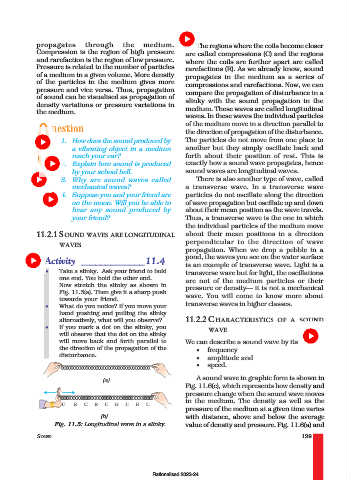Page 140 - Understanding NCERT Science 09
P. 140
propagates through the medium. The regions where the coils become closer
Compression is the region of high pressure are called compressions (C) and the regions
and rarefaction is the region of low pressure. where the coils are further apart are called
Pressure is related to the number of particles rarefactions (R). As we already know, sound
of a medium in a given volume. More density propagates in the medium as a series of
of the particles in the medium gives more compressions and rarefactions. Now, we can
pressure and vice versa. Thus, propagation compare the propagation of disturbance in a
of sound can be visualised as propagation of slinky with the sound propagation in the
density variations or pressure variations in
medium. These waves are called longitudinal
the medium.
waves. In these waves the individual particles
of the medium move in a direction parallel to
Q 1. How does the sound produced by the direction of propagation of the disturbance.
uestion
The particles do not move from one place to
another but they simply oscillate back and
a vibrating object in a medium
forth about their position of rest. This is
reach your ear?
2. Explain how sound is produced
sound waves are longitudinal waves.
by your school bell. exactly how a sound wave propagates, hence
3. Why are sound waves called There is also another type of wave, called
mechanical waves? a transverse wave. In a transverse wave
4. Suppose you and your friend are particles do not oscillate along the direction
on the moon. Will you be able to of wave propagation but oscillate up and down
hear any sound produced by about their mean position as the wave travels.
your friend? Thus, a transverse wave is the one in which
the individual particles of the medium move
11.2.1 SOUND WAVES ARE LONGITUDINAL about their mean positions in a direction
perpendicular to the direction of wave
WAVES
propagation. When we drop a pebble in a
Activity _____________11.4 pond, the waves you see on the water surface
is an example of transverse wave. Light is a
• Take a slinky. Ask your friend to hold transverse wave but for light, the oscillations
one end. You hold the other end. are not of the medium particles or their
Now stretch the slinky as shown in pressure or density— it is not a mechanical
Fig. 11.5(a). Then give it a sharp push
towards your friend. wave. You will come to know more about
• What do you notice? If you move your transverse waves in higher classes.
hand pushing and pulling the slinky
alternatively, what will you observe? 11.2.2 CHARACTERISTICS OF A SOUND
• If you mark a dot on the slinky, you WAVE
will observe that the dot on the slinky
will move back and forth parallel to We can describe a sound wave by its
the direction of the propagation of the
• frequency
disturbance.
• amplitude and
• speed.
A sound wave in graphic form is shown in
(a)
Fig. 11.6(c), which represents how density and
pressure change when the sound wave moves
in the medium. The density as well as the
pressure of the medium at a given time varies
(b) with distance, above and below the average
Fig. 11.5: Longitudinal wave in a slinky. value of density and pressure. Fig. 11.6(a) and
SOUND 129
Rationalised 2023-24

